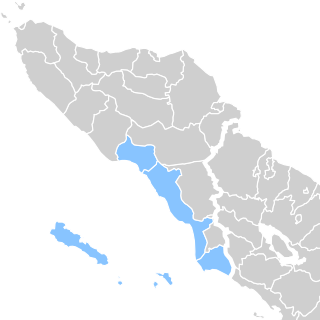Jamee language
This article or section is in a state of significant expansion or restructuring. You are welcome to assist in its construction by editing it as well. If this article or section has not been edited in several days, please remove this template. If you are the editor who added this template and you are actively editing, please be sure to replace this template with {{in use}} during the active editing session. Click on the link for template parameters to use.
This article was last edited by Cal1407 (talk | contribs) 5 seconds ago. (Update timer) |
| Jamee | |
|---|---|
| Bahaso Jamèë | |
| Native to | Indonesia (Aceh) |
| Region | Coastal areas of Aceh Singkil, South Aceh, Southwest Aceh and Simeulue |
| Ethnicity | Aneuk Jamee |
Native speakers | (87,000 cited 1981)[1] |
| Dialects |
|
| Latin (Indonesian alphabet) | |
| Language codes | |
| ISO 639-3 | – |
| Glottolog | aneu1237 |
 Areas where the Jamee language is spoken by a significant minority of the population | |
The Jamee language (Jamee: Bahaso Jamèë), sometimes also called the Aneuk Jamee language, is a dialect of the Minangkabau language generally spoken by the Aneuk Jamee people, descendants of Minangkabau migrants who began migrating from present-day West Sumatra to Aceh in the 17th century and have assimilated with the Acehnese people and culture.[2] The Jamee language is primarily spoken in the southern and western coast, specifically in the coastal areas of South Aceh, West Aceh and Aceh Singkil Regency.
Today, most members of the Aneuk Jamee ethnic group, particularly those living in areas dominated by the Acehnese, such as in West Aceh Regency, generally also speak and use Acehnese as their daily language. Meanwhile, in areas with a higher population of Aneuk Jamee people, such as certain subdistricts in South Aceh and Southwest Aceh Regencies, the Aneuk Jamee language is used more extensively.
Classification
[edit]Distribution and usage
[edit]The Jamee language is primarily spoken in the southern coast of Aceh and a small portion on the west coast.[3] The population of the Aneuk Jamee people is not concentrated in only one area, because they live in groups in several sub-districts in South Aceh Regency, namely Susoh, Manggeng, Labuhan Haji, Samadua, and Tapaktuan. Aneuk Jamee residents also live in Johan Pahlawan Subdistrict, Kaway XVI, and Kuala Subdistrict in West Aceh Regency. Most of the Aneuk Jamee people reside in the small coves which are a series of other bays that lie along the southern coast of Aceh above the lowlands which are flanked by the Bukit Barisan mountains range.[3] The sub-district which is the residence of Aneuk Jamee is separated from each other by sub-districts that are inhabited by other ethnic groups, such as the Acehnese, Kluet, and other ethnic groups in South Aceh.[3]
References
[edit]- ^ Abdullah et. al. 1990, p. 1.
- ^ Ansari, Khairil; Mardhatillah, Mardhatillah (2020-10-21). "The Role Of Aneuk Jamee Culture In The Forming Of Millenary Characters In The Industrial Revolution 4.0". Proceeding International Conference on Language and Literature (IC2LC). 0 (0): 1–5.
- ^ a b c Nelmawarnia; Triana, Hetti Waluati; Kustati, Martin; Rahman, Fadzilah Abdurrahman; Warnis; Syafruddin; Reflinaldi (2020). "Minangkabau Migration in Aceh During the Colonial Era: The Reconstruction of Aneuk Jamee's Identity" (PDF). International Journal of Innovation, Creativity and Change. 14 (3): 1079–1095. ISSN 2201-1323.
Bibliography
[edit]- Abdullah, Wamad; Marlian, Syamsuar; Rohana, Sitti; Gade, M. Hasan (1990). Morfologi dan Sintaksis Bahasa Jamee [Morphology and Syntax of the Jamee Language] (PDF) (in Indonesian). Jakarta: Language Development and Cultivation Center, Department of Education and Culture.
- Abdullah, Wamad; Marlian, Syamsuar; Rohana, Sitti; Usman, Bustami (1991). Struktur Bahasa Jamee [Structure of the Jamee Language] (PDF) (in Indonesian). Jakarta: Language Development and Cultivation Center, Department of Education and Culture.
- Yusuf, Husni; Mahmud, Saifuddin; Ali, Zaini; Ibrahim, Ridwan (1998). Tata Bahasa Jamee [Grammar of the Jamee Language] (PDF) (in Indonesian). Jakarta: Language Development and Cultivation Center, Department of Education and Culture.
